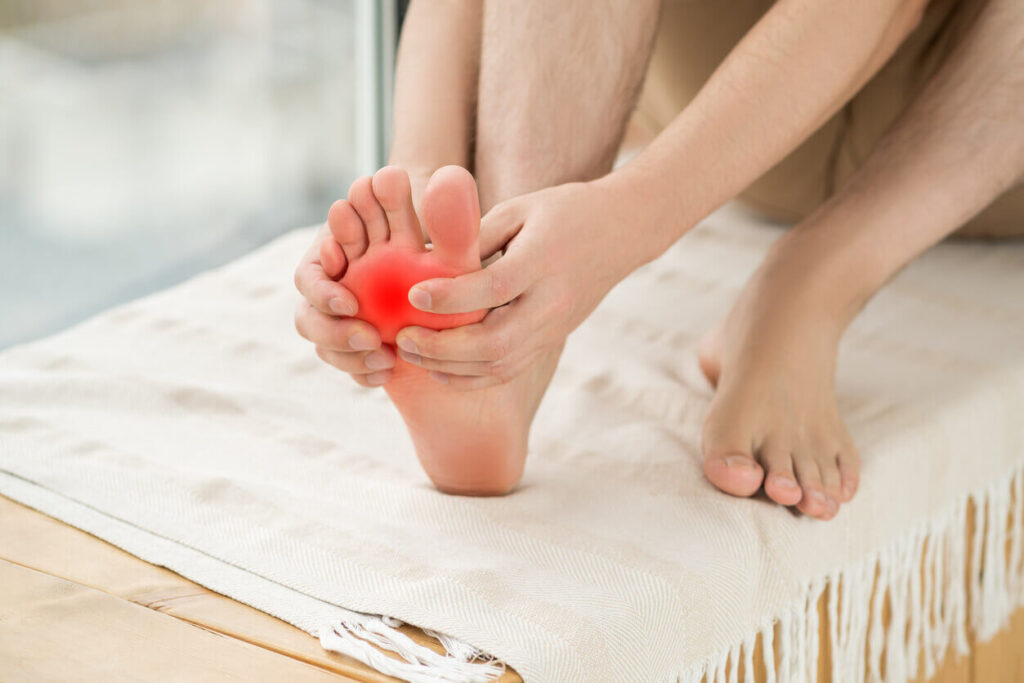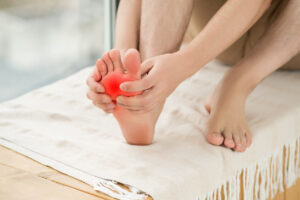I’ve seen it countless times in my practice: a patient hobbles in, wincing with every step. That first step out of bed in the morning feels like stepping on a sharp rock. This sharp, stabbing sensation in the heel is often the tell-tale sign of plantar fasciitis, a condition that can disrupt every part of your life. If you’re dealing with this kind of persistent foot pain, you may feel frustrated and unsure where to turn. Many people don’t realize that a chiropractor can offer effective, non-invasive solutions to get you back on your feet.
Dealing with foot pain is more than just a physical problem; it affects your mood, your work, and your ability to enjoy simple activities like a walk in the park. I believe in treating the whole person, not just the symptom. When it comes to plantar fasciitis, that means looking beyond the foot itself to understand the root cause of your pain. Let’s explore how chiropractic care can offer a path to lasting relief.
What is Plantar Fasciitis?
Before we talk about solutions, it’s important to understand the problem. The plantar fascia is a thick band of tissue that runs across the bottom of your foot, connecting your heel bone to your toes. It acts like a shock absorber, supporting the arch of your foot.
Plantar fasciitis occurs when this ligament becomes inflamed, irritated, or strained. Over time, this can cause small tears in the fascia, leading to that characteristic stabbing pain, especially with your first steps in the morning or after long periods of rest.
Common Causes of Plantar Fasciitis
I like to tell my patients that our bodies are incredible machines, but they are subject to wear and tear, especially when they are out of balance. Several factors can contribute to developing this painful condition:
- Foot Mechanics: Having flat feet or high arches can affect the way your weight is distributed, placing extra stress on the plantar fascia.
- Occupation: Jobs that require long hours of standing or walking on hard surfaces put you at higher risk.
- Physical Activity: Repetitive impact from activities like running or jumping can strain the fascia. I often see this in athletes who increase their training intensity too quickly.
- Weight: Excess body weight puts more pressure on your feet, increasing the load on the plantar fascia.
- Improper Footwear: Shoes that lack proper arch support contribute significantly to the development of foot pain.
How a Chiropractor Can Relieve Your Foot Pain
Many people associate chiropractors with back and neck pain, but our expertise extends to the entire musculoskeletal system—including your feet. A chiropractor looks at the body as an interconnected system. The alignment of your spine, hips, and knees directly impacts how your feet function. When one part is out of alignment, it can create a chain reaction of compensation that leads to problems elsewhere, like in your foot.
Our goal is to address the structural source of your foot pain, not just mask the symptoms. Here’s how we can help:
- Reduces Inflammation: Chiropractic adjustments and therapies help decrease inflammation in the plantar fascia.
- Improves Biomechanics: By correcting misalignments in the feet, ankles, and even the spine, we can improve your body’s overall mechanics.
- Restores Mobility: Gentle adjustments can restore proper movement to the joints in your feet and ankles that may have become stiff or “stuck.”
- Provides Lasting Relief: By addressing the root cause, chiropractic care aims for a long-term solution rather than a temporary fix.
Chiropractic Treatments for Plantar Fasciitis
When a patient comes to me with foot pain, I create a personalized treatment plan based on their specific condition. This isn’t a one-size-fits-all approach. Your care plan may include one or more of the following effective therapies.
Foot Adjustments
Just like the vertebrae in your spine, the 26 bones in your foot can become misaligned. I like to tell my patients that these misalignments, which we call subluxations, are an abnormal condition that exists normally in all people. A chiropractic foot adjustment involves applying a precise, gentle force to these joints to restore their proper position and mobility. This can instantly relieve pressure on the plantar fascia and surrounding tissues, improving function and reducing pain.
Deep Tissue Percussive Massage
To target the soft tissues directly, we often use deep tissue percussive massage. This therapy uses a specialized handheld device that delivers rapid, concentrated pulses deep into the muscles and fascia. It’s fantastic for breaking up scar tissue and adhesions that have formed in the plantar fascia and calf muscles. This increases blood flow to the area, which speeds up healing and provides significant pain relief.
Shockwave Therapy
Shockwave therapy is a cutting-edge treatment that has shown incredible results for chronic plantar fasciitis. This non-invasive procedure uses acoustic waves to stimulate a healing response in the damaged tissue. These energy waves trigger the body’s natural repair mechanisms, promoting cell regeneration, reducing inflammation, and breaking down calcifications that can form in the heel. Many of my patients have found this therapy to be the key to finally overcoming their stubborn foot pain.
What to Expect at Your First Visit
If you’re looking for a chiropractor near you to help with your foot pain, your first appointment will start with a conversation. I always take the time to listen to my patients, to understand their history, their lifestyle, and how their pain is affecting them. This is followed by a thorough physical examination.
I’ll assess your posture, gait (how you walk), and range of motion. I will also perform specific orthopedic tests and palpate the bones and muscles in your feet, ankles, and legs to identify any misalignments or areas of tension. In some cases, we may take X-rays to get a clearer picture of your foot’s structure. Based on this comprehensive evaluation, I will explain my findings and recommend a personalized treatment plan.
Taking Control: At-Home Care and Prevention
Part of my job is to empower you to take an active role in your recovery. In addition to in-office treatments, I will provide you with guidance on things you can do at home to support your healing and prevent future flare-ups.
- Stretching: Gentle calf and foot stretches are crucial for keeping the plantar fascia flexible.
- Proper Footwear: Invest in shoes with good arch support and cushioning. Avoid going barefoot on hard surfaces.
- Icing: Applying ice to your heel for 15-20 minutes can help reduce inflammation and pain after a long day.
- Rest: Give your feet a break from high-impact activities while they are healing.
Find a Chiropractor Near You for Foot Pain Relief
You don’t have to live with the daily struggle of plantar fasciitis. That sharp heel pain doesn’t have to be the first thing you feel every morning. Chiropractic care offers a safe, effective, and natural approach to treating the source of your foot pain, helping you return to the activities you love without discomfort.
If you’re in the South Jersey area, I invite you to visit us at Dr. J Zimmerman Health First Chiropractic Clinics in Galloway, NJ. We’re passionate about helping our neighbors walk comfortably again—and nothing means more than hearing how lives have changed for the better right here in our office.
If you’re tired of temporary solutions and ready for lasting relief, it’s time to seek help. A thorough evaluation from a qualified chiropractor can determine the underlying cause of your pain and set you on the right path to recovery. Check out what patients are saying about their experiences with us by reading our reviews, or take the first step and call to schedule your visit today. Find a trusted chiropractor near you and let’s get you back on your feet.
Frequently Asked Questions (FAQs)
Q: How many chiropractic sessions will I need for plantar fasciitis?
A: The number of sessions varies for each person. It depends on the severity of your condition, how long you’ve had it, and how your body responds to treatment. I will outline a projected timeline after your initial examination.
Q: Are chiropractic adjustments for the foot painful?
A: Most patients find foot adjustments to be a relief. The techniques are gentle and precise. You might feel a popping sound, which is simply gas being released from the joint, similar to cracking your knuckles.
Q: Can a chiropractor help with other types of foot pain?
A: Yes. Chiropractors can treat a wide range of foot-related issues, including bunions, neuromas, and pain from flat feet or high arches by addressing the underlying biomechanical problems.
Meta Information
Meta Title: Chiropractic for Plantar Fasciitis: Stop Foot Pain
Meta Description: Suffering from heel pain? Learn how a chiropractor can treat plantar fasciitis with foot adjustments, shockwave therapy, and more. Find relief near you.



